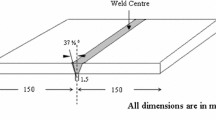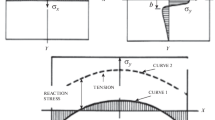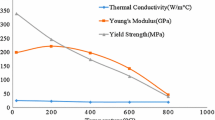Abstract
Subsurface stresses in welded structures increase the likelihood of fatigue cracks and environmental induced material degradation. The ability to evaluate stresses at the surface as well as in the interior of welded structural members would substantially increase the accuracy of structure life estimation. The longitudinal critically refracted (L CR) wave is a bulk longitudinal mode that travels within an effective depth underneath the surface. It may be used to detect in-plane subsurface stresses in the structures. This paper presents a three dimensional thermo-mechanical analysis to evaluate welding residual stresses in dissimilar plate-plate joint of AISI stainless steel 304 and Carbon Steel A106-B type. After finite element simulation, the residual stresses were evaluated by L CR ultrasonic waves. Finally the results of two methods were compared and verified by hole-drilling method. This paper introduces a combination of “Finite Element Welding Simulation” and “Ultrasonic Stress Measurement using the L CR Wave” which is called as “FEL CR”. The capabilities of FEL CR″. The capabilities of FEL CR in residual stress measurement are confirmed here. And also this paper evaluates residual stresses of dissimilar welded joints by LCR ultrasonic waves. It has been shown that predicted residual stress from three dimensional FE analyses is in reasonable agreement with measured residual stress from LCR method and also the results of both are verified with hole-drilling experimental measurements.
Similar content being viewed by others
References
Macherauch, E. and Kloss, K.H., Proc. International Conference on Residual Stresses, FRG: Gramish-Partenkirchen, 1986, pp. 3–26.
Grayli, N. and Shyne, J.C., Effect of Microstructure and Prior Austenite Grain Size on Acoustic Velocity and Attenuation in Steel, Rev. Prog. NDE, Ser. B 1985, vol. 4, pp. 927–936.
Herzer, R. and Schneider, E., Instrument for the Automated Ultrasonic Time-of-Flight Measurement a Tool for Materials Characterization, Springer, 1989, pp. 673–680.
Palanchamy, P., Joseph, A., and Jayakumar, T., Ultrasonic Velocity Measurements for Estimation of Grain Size in Austenitic Stainless Steel, NDT E. Int., 1995, vol. 28, no. 3, pp. 179–185.
Papadakis, E.P., Physical Acoustics and Microstructure of Iron Alloys, Int. Mater. Rev., 1984, vol. 29, pp. 1–24.
Hakan Gür, C. and Orkun Tuncer, B., Nondestructive Investigation of the Effect of Quenching and Tempering on Medium-Carbon Low Alloy Steels, Int. J. Microstruct. Mater. Prop., 2005, vol. 1, no. 1, pp. 51–60.
Ploix, M.A., El Guerjouma, R., Moysan, J., Corneloup, G., and Chassignole, B., Acoustical Characterization of Austenitic Stainless-Steel Welds for Experimental and Modeling, NDT. J. Soc. Adv. Sci., 2005, vol. 17, no. 1, pp. 76–81.
Spies, M. and Schneider, E., Non-Destructive Analysis of Texture in Rolled Sheets by Ultrasonic Techniques, Text Microstruct., 1990, vol. 12, pp. 219–213.
Johnson, G.C., Acoustoelastic Response of a Polycrystalline Aggregate with Orthotropic Texture, J. Appl. Mech., 1985, vol. 52, pp. 659–663.
Sayers, C.M., Ultrasonic Velocities in Anisotropic Polycrystalline Aggregates, J. Phys., Ser. D, 1982, vol. 15, pp. 2157–2167.
Hakan Gür, C. and Çam, İ, Comparison of Magnetic Barkhausen Noise and Ultrasonic Velocity Measurements for Microstructure Evaluation of SAE 1040 and SAE 4140 Steels, Mater. Charact., 2007, vol. 58, no. 5, pp. 447–454C.
Nam, Y.H., Kim, Y.I., and Nahm, S.H., Evaluation of Fracture Appearance Transition Temperature to Forged 3Cr-1Mo-0.25V Steel Using Ultrasonic Characteristics, Mater. Lett., 2006, vol. 60, pp. 3577–3581.
Cantrell, J.H. and Salama, K., Acoustoelastic Characterization of Materials, Int. Mater. Rev., 1991, vol. 36, pp. 125–145.
Salama, K., Relationship between Temperature Dependence of Ultrasonic Velocity and Stress, Quantitative Non-Destructive Evaluation, 1985, pp. 1109–1119.
Mohbacher, H., Schneider, E., and Goebbels, K., Temperature Dependence of Third-Order Elastic Constants, in Proc. 9th International Conference on Experimental Mechanics, 1990, vol. 3, pp. 1189–1197.
Crecraft, D.I., The Measurement of Applied and Residual Stresses in Metals Using Ultrasonic Waves, J. Sound. Vib., 1967, vol. 5, no. 1, pp. 173–192.
Lhémery, A., Calmon, P., Chatillon, S., and Gengembre, N., Modeling of Ultrasonic Fields Radiated by Contact Transducer in a Component of Irregular Surface, Ultrasonics, 2002, vol. 40, pp. 231–236.
Chakravati, A.P., Malik, L.M., and Goldak, J.A., Prediction of Distortion and Residual Stresses in Panel Welds, in Computer Modelling of Fabrication Processes and Constitutive Behaviour of Metals, 1986, pp. 547–561.
Goldak, J. and Bibby, M., Computational Thermal Analysis of Welds, Modeling Casting Welding Processes, 1988, vol. 4, pp. 153–166.
Hibbitt, H. and Marcal, P.V., A Numerical, Thermo-Mechanical Model for the Welding and Subsequent Loading of a Fabricated Structure, Comput. Struct., 1973, vol. 3, pp. 1145–1174.
Argyris, J.H., Szimmat, J., and Willam, K.J., Computational Aspects of Welding Stress Analysis, Comput. Methods Appl. Mechan. Eng., 1982, vol. 33, pp. 635–666.
Rybicki, E.F., Schmueser, D.W., Stonesifer, R.B., Groom, J.J., and Mishler, H.W., A Finite-Element Model for Residual Stresses and Deflections in Girth-Butt Welded Pipes, J. Pressure Vessel Technol., 1978, vol. 100, pp. 256–262.
Papazoglou, V.J. and Masubuchi, K., Numerical Analysis of Thermal Stresses during Welding Including Phase Transformation Effects, J. Pressure Vessel Technol., 1982, vol. 104, pp. 198–203.
Ueda, Y., Murakawa, K.H., Ma, N.X., and Maeda, H., FEM Analysis of 3-D Welding Residual Stresses and Angular Distortion in T-type Fillet Welds, Trans. JWRI, 1995, vol. 24, no. 2, pp. 115–122.
Egle D.M. and Bray, D.E., Measurement of Acoustoelastic and Third Order Elastic Constants for Rail Steel, J. Acoust. Soc. Am., 1976, vol. 60, no. 3, pp. 741–744.
Bray, D.E. and Stanley, R.K., Nondestructive Evaluation, Boca Raton: CRC Press, FL Revised Ed., 1997.
Brekhovskii, L.M., Waves in Layered Media, Academic Press, 1960, vol. 1.
Basatskaya, L.V. and Ermolov, I.N., Theoretical Study of Ultrasonic Longitudinal Subsurface Waves in Solid Media, 1980.
Junghans, P. and Bray, D.E., Beam Characteristics of High Angle Longitudinal Wave Probes, R.N. Pangbom, 1991.
Langenberg, K.J., Fellenger, P., and Marklein, R., On the Nature of the So-Called Subsurface Longitudinal Wave and/or the Surface Longitudinal “Creeping” Wave, Res. Nondest. Eval., 1990, vol. 2, pp. 59–81.
Bray Don, E. and Tang, Wei, Evaluation of Stress Gradients in Steel Plates and Bars with the L CR Ultrasonic Wave, Nucl. Eng. Design, 2001, vol. 207, pp. 231–240.
Goldak, J. and Akhlaghi, M., Computational Welding Mechanics, Springer, 2005.
Lindgren, L.E., Finite Element Modelling and Simulation of Welding, Part 2: Improved Material Modeling, J. Therm. Stress, 2001, vol. 24, pp. 195–231.
Lindgren, L.E. and Hedblom, R., Modelling of Addition of Filler Material in Large Deformation Analysis of Multipass Welding, Commun. Numer. Methods Eng., 2001, vol. 17, pp. 647–657.
Chang, P. and Teng, T., Numerical and Experimental Investigations on the Residual Stresses of the Butt-Welded Joints, Comput. Mater. Sci., 2004, vol. 29, pp. 511–522.
Schaeffler, A., Constitution Diagram for Stainless Steel Weld Metal, Metal. Progress, 1949, pp. 680–680.
Lindgren, L.E., Finite Element Modelling and Simulation of Welding, Part 1: Increased Complexity, J. Therm. Stress, 2001, vol. 24, pp. 141–192.
Deng, D. and Murakawa, H., Numerical Simulation of Temperature Field and Residual Stress in Multi-Pass Welds in Stainless Steel Pipe and Comparison with Experimental Measurements, Comput. Mater. Sci., 2006, vol. 37, no. 3, pp. 269–277.
Qozam, H., Chaki, S., Bourse, G., Robin, C., Walaszek, H., and Bouteille, P., Microstructure Effect on the L CR Elastic Wave for Welding Residual Stress Measurement, Exp. Mechan., 2010, vol. 50, pp. 179–185.
Author information
Authors and Affiliations
Corresponding author
Additional information
The article is published in the original.
Rights and permissions
About this article
Cite this article
Javadi, Y., Najafabadi, M.A. & Akhlaghi, M. Residual stress evaluation in dissimilar welded joints using finite element simulation and the L CR ultrasonic wave. Russ J Nondestruct Test 48, 541–552 (2012). https://doi.org/10.1134/S1061830912090033
Received:
Published:
Issue Date:
DOI: https://doi.org/10.1134/S1061830912090033




